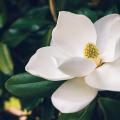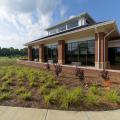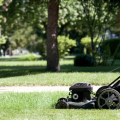Green Roofs for Southern Landscapes
 Green roofs are vegetative alternatives to traditional roofing materials. Instead of having asphalt, gravel, or shingles on a roof, live plants and growing media are placed.
Green roofs are vegetative alternatives to traditional roofing materials. Instead of having asphalt, gravel, or shingles on a roof, live plants and growing media are placed.
Sod covered houses were common throughout much of Europe and western North America, yet new technologies are allowing for their use on modern residential, commercial, and industrial buildings. Consisting of vegetation, a growing medium, impermeable membranes, drainage, and sometimes supplemental irrigation; green roofs offer the following benefits to a structure:
- Reduces high summer heat temperatures on structures (by as much as 20 degrees Fahrenheit).
- Absorbs rainwater and reduces stormwater runoff.
- Reduces noise from traffic and urban sounds.
- Provides an additional living environment for birds and animals.
- Is an attractive solution for views of rooftops.
- Protects roof materials from sun exposure and temperature fluctuations.
- Provides additional insulation for building interiors.
 Green roofs are either intensive or extensive, referring to the soil media depth and ultimate weight upon the roof. Intensive green roofs have growing media’s ranging from 8” to 24”, which allow for the inclusion of larger shrubs and even trees, with weight loads ranging from 60 to 200 pounds per square foot. Intensive roofs require more regular maintenance and are suited to structures that can support heavier loads. Extensive green roofs have shallower soils from 2” to 7” typically allowing for herbaceous plants and groundcovers, and weight loads ranging from 16 to 35 pounds per square foot. This is usually more suitable for existing roof types as it is lighter in weight. Maintenance considerations are generally lower for extensive types. With any green roof project, an architect or structural engineer should determine the weight loads that the roof will support.
Green roofs are either intensive or extensive, referring to the soil media depth and ultimate weight upon the roof. Intensive green roofs have growing media’s ranging from 8” to 24”, which allow for the inclusion of larger shrubs and even trees, with weight loads ranging from 60 to 200 pounds per square foot. Intensive roofs require more regular maintenance and are suited to structures that can support heavier loads. Extensive green roofs have shallower soils from 2” to 7” typically allowing for herbaceous plants and groundcovers, and weight loads ranging from 16 to 35 pounds per square foot. This is usually more suitable for existing roof types as it is lighter in weight. Maintenance considerations are generally lower for extensive types. With any green roof project, an architect or structural engineer should determine the weight loads that the roof will support.
There are a number of different techniques, materials, and growing media’s that may be used on a green roof project, and may vary according to the structure. Typically, directly on top of the roof is a separation layer, followed by layers of insulation, moisture barrier, waterproofing, drainage protection, drainage, filter fabric, growing media, and finally plants. The pitch of the roof should range between 5 and 20 degrees in slope for positive water drainage. Additional drainage layers or pipes may be needed for flat roof types. According to the U.S. Environmental Protection Agency report on Green Roofs, average national costs for an extensive green roof is approximately $8 per square foot for materials, preparation and installation.
Plant species that are suitable for green roofs in the Southern United States are still being researched, but the following types have been used in these regional project examples:
University of Central Florida Student Union, Orlando, Florida
Dune sunflower (Helianthus debilis)
Blanket pinwheel daisy (Gaillardia pulchella)
Painted daisy (Tanacetum coccineum)
Coral honeysuckle (Lonicera sempervirens)
Simpson’s stopper (Myrcianthes fragrans)
Confederate jasmine (Trachelospermum jasminoides)
Charles Perry Construction Yard, University of Florida, Florida
Blanketflower (Gaillardia pulchella)
Blazing star (Liatris spicata)
Blue-eyed grass (Sisyrinchium atlanticum)
Coreopsis (Coreopsis grandiflora)
Dune Sunflower (Helianthis debilis)
Gopher apple (Licania michauxii)
Matchstick weed (Phyla nodiflora)
Muhly grass (Muhlenbergia capillaries)
Perennial peanut (Arachis glabrata)
Red salvia (Salvia coccinea)
Lady Bird Johnson Wildflower Center Green Roof Research, Texas
Crossvine (Bignonia capreolata)
Sideoats grama (Bouteloua curtipendula)
Buffalo grass (Bouteloua dactyloides)
Blue grama (Bouteloua gracilis)
Texas grama (Bouteloua rigidiseta)
Texas sedge (Carex texensis)
Gregg dalea (Dalea greggii)
Purple coneflower (Echinacea purpurea)
Red yucca (Hesperaloe parviflora)
Curly mesquite (Hilaria belangeri
False aloe (Manfreda maculosa)
Seep muhly (Muhlenbergia reverchonii)
Meadow muhly (Muhlenbergia rigens)
Mexican wiregrass (Nassella tenuissima)
Hall’s panicgrass (Panicum hallii)
Scarlet penstemon (Penstemon triflorus)
Texas frogfruit (Phyla nodiflora)
Mealy sage (Salvia farinacea)
Autumn sage (Salvia greggii)
Little bluestem (Schizachyrium scoparium)
Bushy skullcap (Scutellaria wrightii)
Woolly stemodia (Stemodia lanata)
Bitterweed (Tetraneuris scaposa)
Haley Center, Auburn University, Alabama
Prairie aster (Aster hemisphericus)
Aromatic aster (Aster oblongifolius)
Coreopsis (Coreopsis grandiflora)
Prairie coneflower (Echinacea angustifolia)
Garden phlox (Phlox paniculata)
Prairie phlox (Phlox pilosa)
Obedient plant (Physostegia angustifolia)
Black-eyed Susan (Rudbeckia hirta)
White goldenrod (Solidago ptarmicoides)
Stokes aster (Stokesia laevis)
Muhly grass (Muhlenbergia capillaries)
Sweet grass (Muhlenbergia filipes)
For more information on green roofs, visit the following public Web sites:
Images are available in higher resolution: Top | Bottom
These factsheets were written by Robert F. Brzuszek, Assistant Extension Professor, The Department of Landscape Architecture, Mississippi State University.
Publications
News
Landscape design and natural landscape enthusiasts will gather at Mississippi State University to perfect their craft and learn from other experts, an annual event happening this year on Oct. 18. The 68th Edward C. Martin Landscape Symposium will be held from 8:30 a.m. to noon at the Bost Auditorium at MSU.
May is here and you know what that means, it’s go time!




